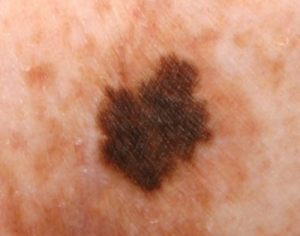Is it possible for a really bad looking or “ugly” melanoma to still be early stage, in situ and very thin?
Or is ugliness predictive of a late stage diagnosis?
Perhaps you’ve seen those unsettling images of melanoma, all jagged, scabby, crusty or just in general a spooky looking thing that resembles a spot of dried tar.
When melanoma is treated at its thinnest, when it’s confined to only the upper layer of the skin (epidermis), the survival rate is 99% 10 years out.
Advanced melanoma has an extremely grim prognosis. This cancer doesn’t respond to chemotherapy like other cancers do.
Furthermore, its favored locations for metastases are the lungs and brain.
Can an ugly, crusty or black melanoma still be early stage?
Is appearance of melanoma correlated to stage of disease?

Melanoma
“So, dermatology is all about differential diagnoses, and melanoma can sometimes mimic many other skin conditions, leading to a misinterpretation of its severity,” begins Alpana Mohta, MD, DNB, a dual board certified dermatologist who specializes in clinical and aesthetic dermatology.
“While melanoma may exhibit concerning features such as noticeable scabs, very dark raised portions, jagged borders or a predominantly black appearance, it is still possible for it to be in the early stage, known as in situ.”
There are different types of melanoma, but the most common type is called superficial spreading.
It grows laterally or increases in size within the top-most layer of skin before it starts penetrating into the second layer of skin (dermis).
As it spreads superficially, it may acquire some scary looking features.
But this is no reason to wait for a suspicious but fairly normal looking mole to start turning ugly before having a dermatologist inspect it.
Dr. Mohta continues, “Melanoma mimickers can sometimes confuse and make it challenging to differentiate between benign and malignant lesions.”
But the following mimickers can’t fool an experienced pathologist examining a tissue sample under a microscope.
Seborrheic Keratosis

Seborrheic keratosis
“This common benign skin growth can appear dark, raised and have a warty surface, resembling melanoma,” says Dr. Mohta.
“However, seborrheic keratosis is non-cancerous.”
Seborrheic keratoses are not likely to be found in younger adults.
So if a 25-year-old thinks the new, growing spot on his face or chest is a seborrheic keratosis, he should waste no time having a dermatologist look at it.
Hemangioma

Hemangiomas or angiomas
“These are benign blood vessel growths that can sometimes have a dark or black appearance, which may resemble melanoma,” says Dr. Mohta.
“However, they are also benign.” Many can start appearing anywhere on the body, sometimes in large numbers.
Like seborrheic keratoses, hemangiomas (also known as angiomas or cherry angiomas) are hallmarks of getting into middle age.
Lentigo

Lentigo
“Lentigines are flat, brown spots on the skin that can be mistaken for melanoma due to their pigmentation,” says Dr. Mohta.
“However, lentigines do not exhibit the same potential for malignancy, unlike melanoma.”
This doesn’t mean that a lentigo, also sometimes called an age related sunspot, can’t ever become malignant.
It’s still possible. Lentigos typically start appearing in middle age and can look just like a mole. Have any new spots checked by your dermatologist.
Pigmented Basal Cell Carcinoma

Basal cell carcinoma
Dr. Mohta explains, “Although basal cell carcinoma is a type of skin cancer, the pigmented variant can share similarities with melanoma in terms of color and appearance.”
BCC is rarely fatal, but if left untreated, will devastate surrounding tissue including bone.
Dermatofibroma

Dermatofibroma. Mohammad2018 CC BY-SA
“Dermatofibromas are benign skin growths that often appear as a dark, raised bump.
“They can mimic melanoma in terms of color and elevation.”
Early and Advanced Melanoma and Their Appearance
While the above conditions can prolifically masquerade as melanoma, the opposite is also quite true:
Melanoma can mimic benign conditions or BCC.
Furthermore, a “not so bad looking mole” can be a melanoma that has penetrated into deeper layers of the skin.
So if a scary looking, really black or crusty spot may actually be an in situ melanoma, and if a more even-tempered-looking spot can actually be a deep melanoma – then just what should you do if you discover a suspicious spot?
- Don’t ask what your partner thinks of it.
- If your primary care physician says it’s nothing to worry about, pretend you didn’t hear that.
- Have a dermatologist examine it.
- Trust your gut and request a biopsy.
Anything on your skin that’s new, getting bigger, beginning to itch or is otherwise evolving needs to be examined by a dermatologist.
A deep melanoma isn’t always ugly.
Dr. Mohta explains five things you should know about melanoma.
 Dr. Alpana Mohta is a dual board certified dermatologist and owner of dralpana.com. Her areas of interest include clinical dermatology, dermatopathology and dermatosurgery. She has over 85 research publications in numerous journals. Apart from her regular medical practice, she is also a medical writer, reviewer and advisor for many companies.
Dr. Alpana Mohta is a dual board certified dermatologist and owner of dralpana.com. Her areas of interest include clinical dermatology, dermatopathology and dermatosurgery. She has over 85 research publications in numerous journals. Apart from her regular medical practice, she is also a medical writer, reviewer and advisor for many companies.
 Lorra Garrick has been covering medical, fitness and cybersecurity topics for many years, having written thousands of articles for print magazines and websites, including as a ghostwriter. She’s also a former ACE-certified personal trainer.
Lorra Garrick has been covering medical, fitness and cybersecurity topics for many years, having written thousands of articles for print magazines and websites, including as a ghostwriter. She’s also a former ACE-certified personal trainer.
.










































